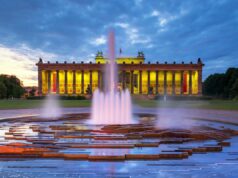The Essentials
Some of Germany’s traditional foods include sausages such as bratwurst and currywurst, sauerkraut, schnitzel, spätzle, black forest cake, and pretzels. More detailed information can be found here…
Some of the most popular celebrations in Germany include Oktoberfest, Christmas, Easter, Karneval (Carnival), Walpurgisnacht, and St. Martin’s Day. More on Germany’s celebrations here…
Typical German traditions include the love for beer, the importance of punctuality, and the appreciation for order and cleanliness. Find out more about German traditions here…
German customs and traditions have a rich and diverse history that has been shaped by various cultural influences over the centuries. From the world-renowned Oktoberfest celebration to the festive Christmas markets, Germany is known for its vibrant and lively traditions that have captivated people from around the world.
Whether it’s the love for beer, the appreciation for classical music, or the importance of punctuality, German customs and traditions continue to play a significant role in shaping the country’s unique cultural identity. In this context, exploring the various facets of German traditions and customs can provide valuable insights into the country’s rich cultural heritage and social fabric.
The Importance of Customs and Traditions

Customs and traditions are an important part of a country’s cultural identity and heritage. They are passed down from generation to generation and play a significant role in shaping a nation’s history, values, and social norms. Here are some reasons why customs and traditions are important for a country:
- Preservation of cultural identity – Customs and traditions help to preserve a country’s cultural identity by passing down important cultural practices, beliefs, and values from one generation to another. They create a sense of continuity and connection to the past and help to maintain a sense of community and shared history.
- Promotion of social cohesion – Customs and traditions promote social cohesion by bringing people together and fostering a sense of shared identity and purpose. They provide opportunities for people to interact with each other and to form connections based on shared beliefs and values.
- Celebration of history and culture – Customs and traditions provide a way to celebrate a country’s history and cultural heritage. They help to showcase the unique aspects of a nation’s culture and provide a sense of pride and identity for its people.
- Reflection of values and beliefs – Customs and traditions reflect the values and beliefs of a society. They provide a way to express and reinforce important cultural values such as respect, hospitality, and community.
- Promotion of tourism and cultural exchange – Customs and traditions can be a major draw for tourists and can help to promote cultural exchange between countries. They provide a unique and authentic experience for visitors and can help to foster a deeper understanding and appreciation of different cultures.
For Tourists

When traveling or visiting a new place, it is important to be aware of and respectful of the local customs and traditions. Here are some reasons why:
- Respect for the local culture – Knowing and respecting local customs and traditions is a way to show respect for the local culture. It shows that you are interested in learning about the local way of life and are willing to adapt to local norms and customs.
- Avoiding offense or cultural misunderstandings – Being aware of local customs and traditions can help you avoid unintentionally offending locals or making cultural mistakes. For example, knowing appropriate dress codes for certain places or occasions can help you avoid offending locals or breaking cultural norms.
- Enhancing cultural experiences – By understanding and participating in local customs and traditions, travelers can enhance their cultural experiences and gain a deeper understanding and appreciation of the local culture. It can also provide an opportunity to interact with locals and learn more about their way of life.
- Safety – In some cases, not being aware of local customs and traditions can lead to safety concerns. For example, not knowing the local laws and customs related to alcohol or drug use can lead to legal trouble or dangerous situations.
- Building positive relationships – By respecting local customs and traditions, travelers can build positive relationships with locals. This can lead to more enriching cultural experiences and can also create a positive image of travelers from their home country.
In conclusion, being aware of and respecting local customs and traditions is an important aspect of travel. It can enhance cultural experiences, avoid offense or cultural misunderstandings, and build positive relationships with locals. By taking the time to learn about and adapt to local customs and traditions, travelers can gain a deeper understanding and appreciation of the local culture and way of life.
Traditional German Food

When it comes to traditions in Germany, an important part of those constitutes the food. Thus, knowing traditional German foods is crucial if you want to find out more about German traditions:
- Bratwurst – a type of German sausage that is usually made from pork and spices. Originating in Thuringia, it has been popular in Germany for over 600 years.
- Sauerkraut – finely chopped cabbage that has been fermented with salt and vinegar. It is a staple side dish in German cuisine and is believed to have originated in China over 2,000 years ago.
- Schnitzel – a thin cutlet of meat that is breaded and fried. It can be made from pork, chicken, or veal and is a popular dish in Germany and Austria.
- Spätzle – a type of soft egg noodle that is popular in southern Germany and Austria. It is usually served as a side dish and can be accompanied by gravy, cheese, or other sauces.
- Kartoffelpuffer – a type of potato pancake that is popular in Germany and Austria. It is made from grated potatoes, flour, and eggs and is often served with applesauce or sour cream.
- Currywurst – a type of sausage that is typically served with a tomato-based sauce that has been seasoned with curry powder. It is a popular fast food in Germany and is believed to have originated in Berlin in the 1940s.
- Leberknödel – a type of dumpling made from liver and other meats that is popular in southern Germany. It is often served with a rich gravy and can be accompanied by potatoes or other vegetables.
- Labskaus – a traditional dish from northern Germany that is made from corned beef, potatoes, and onions. It is usually served with pickles and bread.
- Rouladen – a type of beef roll that is filled with bacon, onions, and pickles. It is often served with gravy and can be accompanied by potatoes or other vegetables.

Traditional German Desserts:
- Apfelstrudel – a type of pastry that is filled with sliced apples, sugar, and cinnamon. It is a popular dessert in Germany and Austria and is often served with vanilla ice cream.
- Bienenstich – also known as Bee Sting Cake, this is a type of sweet yeast cake that is filled with vanilla custard and topped with caramelized almonds. It is a popular dessert in Germany and is believed to have originated in the 15th century.
- Baumkuchen – also known as Tree Cake, this is a type of layered cake that is made by stacking thin layers of cake batter on a spit and slowly roasting it over an open flame. It is a popular dessert in Germany and is often served at weddings and other special occasions.
- Berliner – a type of doughnut that is filled with jam or jelly. It is a popular sweet snack in Germany and is often eaten on New Year’s Eve.
- Dampfnudel – a type of sweet dumpling that is steamed and served with vanilla sauce. It is a popular dessert in southern Germany and Austria.
- Käsekuchen – a type of cheesecake that is made from quark, a type of fresh cheese that is popular in Germany. It is often served with fruit or whipped cream.
- Stollen – a type of fruitcake that is filled with dried fruit and marzipan. It is a popular dessert in Germany and is often eaten during the Christmas season.
- Zimtsterne – also known as Cinnamon Stars, these are small cookies that are made from ground almonds, cinnamon, and powdered sugar. They are a popular Christmas cookie in Germany and are often cut into star shapes.
- Rote Grütze – a type of fruit pudding that is made from red berries such as strawberries, raspberries, and cherries. It is often served with vanilla sauce or ice cream and is popular in northern Germany and Denmark.
- Schwarzwälder Kirschtorte – also known as Black Forest Cake, this is a rich chocolate cake that is layered with whipped cream and cherries. It is a popular dessert in Germany and is named after the Black Forest region.
German Celebrations

Here, you will find some of the most important German celebrations, along with explanations of when they are celebrated and the German customs and traditions that are part of these celebrations:
- Oktoberfest – Celebrated annually in Munich and other parts of Germany, Oktoberfest is a 16-day festival that begins in late September and runs until the first weekend in October. The festival is centered around the consumption of beer and includes traditional Bavarian music, dancing, and food. Many people wear traditional Bavarian clothing, such as lederhosen and dirndls, and participate in parades and other festive events.
- Christmas – Celebrated on December 25th, Christmas is a major holiday in Germany that is typically celebrated with family and friends. Many Germans attend church services and exchange gifts, and Christmas markets are popular throughout the country. Traditional Christmas foods include Stollen (a type of fruitcake), Lebkuchen (a type of gingerbread), and Glühwein (a type of mulled wine).
- Carnival – Celebrated in many parts of Germany in the weeks leading up to Lent, Carnival is a festive season that includes parades, costumes, and music. The largest Carnival celebrations take place in the Rhineland region, where people dress up in elaborate costumes and participate in parades and other festive events. Traditional Carnival foods include Berliner (a type of doughnut) and Krapfen (a type of pastry).
Did you know?
A study conducted by researchers at the University of Erlangen-Nuremberg found that the traditional German custom of Kaffee und Kuchen, or coffee and cake, has mental health benefits for the elderly. The study found that regular social interactions, such as those that occur during Kaffee und Kuchen, can help reduce the risk of depression and cognitive decline in older adults.
- St. Martin’s Day – Celebrated on November 11th, St. Martin’s Day is a religious holiday that honors St. Martin of Tours. Many people participate in lantern parades and eat traditional foods such as roasted goose, dumplings, and red cabbage.
- Easter – Celebrated in late March or early April, Easter is a major holiday in Germany that is typically celebrated with family and friends. Many Germans attend church services and exchange Easter eggs and other gifts. Easter markets are also popular throughout the country. Traditional Easter foods include lamb, Easter bread, and chocolate eggs.
- Advent – Celebrated in the weeks leading up to Christmas, Advent is a time of preparation and reflection. Many Germans light Advent candles and participate in Advent wreath ceremonies. Traditional Advent foods include Stollen, Lebkuchen, and Glühwein.
- Reunification Day – Celebrated on October 3rd, Reunification Day commemorates the reunification of East and West Germany in 1990. Many people attend parades and other festive events to celebrate this important event in German history.
German Customs and Traditions

Germany is a country with a rich cultural diversity, and this diversity is reflected in regional differences between the northern and southern, as well as eastern versus western parts of the country. Here are some of the differences and what visitors need to be aware of:
Northern vs. Southern Germany:
- Dialects: The northern and southern regions of Germany have different dialects, accents, and vocabularies, and visitors may find it difficult to understand some of the local slang and expressions.
- Social Customs: Northern Germans may seem more reserved and formal in social situations, while Southern Germans are generally more outgoing and relaxed. Visitors should be aware of these differences when interacting with locals.
- Cuisine: Northern German cuisine is typically based around seafood and meat dishes, while southern German cuisine is known for its hearty and rich dishes like Spätzle and Schweinshaxe.
Did you know?
A study conducted by the European Environment Agency found that Germany is one of the leading countries in Europe for recycling, with a recycling rate of over 65%. The study found that strict recycling laws and regulations, as well as a strong public awareness of the importance of recycling, have contributed to Germany’s success in this area.
Eastern vs. Western Germany:
- History: Eastern and Western Germany were divided for almost 40 years after World War II, and this division has left a lasting impact on the cultural differences between the two regions.
- Architecture: Visitors to Eastern Germany may notice the prevalence of Soviet-style apartment blocks and large government buildings, while Western Germany is known for its mix of modern and traditional architecture.
- Political Views: Eastern Germany tends to be more left-leaning politically, while Western Germany is more conservative. Visitors should be aware of these differences when discussing politics with locals.
Visitors to Germany should be aware of these regional differences and approach each region with an open mind and a willingness to learn about the local culture. Whether it’s sampling the local cuisine, trying out the local dialect, or learning about the region’s history and politics, taking the time to explore the unique characteristics of each region can lead to a richer and more rewarding travel experience.
Remarkable and Famous Ones

Here is a list of some of the most important German customs and traditions:
- Kaffeeklatsch – A social gathering centered around drinking coffee and eating cake, Kaffeeklatsch is a popular custom in Germany. It is typically held in the afternoon and is a time for friends and family to catch up and socialize.
- Christmas markets – Christmas markets are a beloved tradition in Germany and are held throughout the country during the Advent season. These markets offer a variety of goods, such as handmade crafts, Christmas decorations, and traditional foods and drinks.
- Schultüte – On their first day of school, German children receive a Schultüte, or school cone, filled with small gifts, candy, and school supplies. This tradition is meant to make the first day of school a special and memorable occasion.
- Easter egg decorating – Easter egg decorating is a popular tradition in Germany, and many families spend time together decorating eggs in intricate designs. These decorated eggs are then used in Easter egg hunts and as decorations.
Did you know?
A study conducted by the University of Trier found that the tradition of Fasching, or Carnival, in southern Germany has a positive impact on the local economy. The study found that Fasching generates significant revenue for local businesses, particularly those in the tourism and hospitality industries.
- Fasching – Similar to Carnival, Fasching is a festive season that includes parades, costumes, and music. It is particularly popular in southern Germany and is celebrated in the weeks leading up to Lent.
- Advent calendars – Advent calendars are a popular tradition in Germany and are used to count down the days until Christmas. These calendars typically contain chocolates or small gifts for each day leading up to Christmas.
- Easter fires – A tradition in some parts of Germany in which large bonfires are lit on Easter Sunday or Easter Monday as a way to celebrate the arrival of spring.
- Maibaum – A Maypole or Maibaum is a tall wooden pole that is decorated with flowers and ribbons and erected in a public square or village center. This tradition is meant to welcome the arrival of spring and is celebrated with music, dancing, and food.
The Weirdest Traditions

Here is a list of some weird German traditions and customs:
- Bleigiessen – A New Year’s Eve tradition in which people melt small lead figurines over a flame and then interpret the shapes they create as a way to predict the future.
- Baumklettern – A traditional competition held in some parts of Germany in which people climb up a tall tree trunk as quickly as possible.
- Tischlein Deck Dich – A tradition in which people set up miniature scenes of a family feast, complete with tiny food and drink, as a way to celebrate the holiday season.
- Fingerhakeln – A traditional finger wrestling competition that is popular in Bavaria and Austria.
- Krampuslauf – A bizarre tradition, also extremely popular in Austria, in which people dress up in devilish costumes and run through the streets, scaring children and adults alike.
- Vogelschießen – A traditional shooting competition in which people use a rifle to shoot at a wooden bird perched on a tall pole. The first person to knock down the bird is crowned the winner.
- Maschkera – A Carnival tradition in which people wear elaborate costumes and masks made from wood, animal hides, and other materials. These costumes are meant to represent various mythological and historical figures.
Behavior and Norms

German traditions and customs go beyond just food and festivals. They also include behavioral norms, social customs, and daily habits that are unique to German culture. Here are a few examples:
- Punctuality – Germans are known for being punctual and taking time seriously. Being late is considered disrespectful and can be seen as a sign of bad manners.
- Direct communication – Germans tend to communicate in a straightforward and direct manner, and often value honesty and clarity over politeness.
- Recycling – Germany is known for its strict recycling laws and regulations. It is common for households to separate waste into different categories, such as paper, glass, and plastic.
- Personal space – Germans value personal space and may feel uncomfortable with physical contact or invasion of personal space. It is important to respect this and avoid standing too close to someone or touching them without permission.
Did you know?
A study conducted by the University of Passau found that the tradition of Christmas markets in Germany has a positive impact on social cohesion and community engagement. The study found that Christmas markets provide a space for people to come together and engage in social activities, which helps to strengthen social ties and promote a sense of community.
- Greeting customs – Germans often greet each other with a handshake or a verbal greeting, such as “Guten Tag” (good day) or “Hallo”. It is important to address people by their formal title, such as “Herr” (Mr.) or “Frau” (Mrs.), until given permission to use their first name.
- Table manners – German table manners are formal and strict. It is considered impolite to put your elbows on the table, talk with your mouth full, or use your knife to push food onto your fork.
- Work ethic – Germans are known for their strong work ethic and value hard work and productivity. It is common for people to work long hours and take pride in their work.
- Silence – Germans may be comfortable with moments of silence during conversations or social situations, and may not feel the need to fill every moment with small talk.
These traditions and customs help to define the cultural identity of Germany and reflect the values and behaviors that are important to German people. Understanding and respecting these customs can help visitors navigate social situations and form meaningful connections with the local culture.
Experience the Customs and Traditions Yourself!
German traditions and customs are an important part of the country’s cultural heritage and reflect the values, beliefs, and behaviors that are unique to German culture. From the elaborate festivals and celebrations to the daily habits and social customs, these traditions help to define the cultural identity of the country and connect its people to their past and heritage.
Visitors to Germany can experience these traditions firsthand and gain a deeper appreciation for the diversity and richness of German culture. Whether it’s sampling traditional foods, participating in local festivals, or simply observing the customs and traditions of everyday life, exploring German traditions and customs can be a fascinating and rewarding experience.
FAQ – An Introduction to German Traditions and Customs
Some of the traditions in Germany include the Christmas markets, Oktoberfest, St. Nicholas Day, Carnival, and the Easter tree.
Germany is famous for its rich cultural heritage, which includes the classical music of composers such as Bach, Beethoven, and Mozart, as well as its famous beer, wine, and sausages.
It has the largest economy in Europe, it is home to the world’s oldest universal health care system, it has over 3000 kinds of bread, it has over 25,000 castles, and it is the birthplace of the printing press.


















